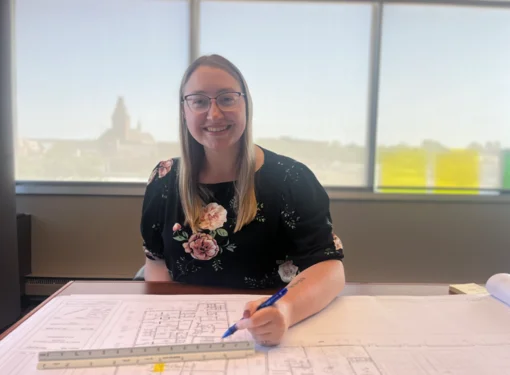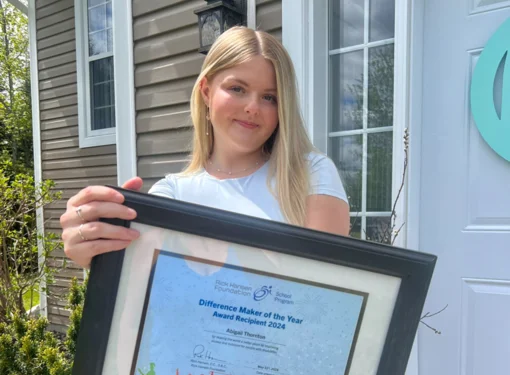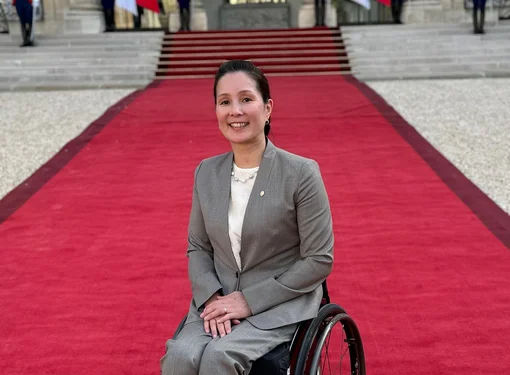Farmer highlights benefits of the Back to Ag program
Above image: André Veilleux uses his stand-up wheelchair to perform farm tasks more independently.
In 2014, the Rick Hansen Foundation was a partner in the Back to Ag program, along with Farm Credit Canada and the Canadian Agricultural Safety Association. The program helps get injured farmers return to work. Here is a story of how André has benefited from the program, courtesy of the Canadian Agricultural Safety Association.
The Back to Ag program was envisioned to help farmers get back to the work they love – farming. André Veilleux, a maple syrup producer from Quebec, is doing just that thanks to his new stand-up wheelchair.
On March 1, 2008, André’s life drastically changed when a maple tree he was felling crushed him, severing his spinal cord, fracturing six vertebrae and resulting in paraplegia. André would never walk again.
His drive and focus have seen him recover in many ways, but he still found some work difficult. “It took two years for my rehabilitation, he says. “And I began to move forward, but every time I wanted to do something, I still needed help.” Through some research, André discovered what exactly he needed – a wheelchair that would help him to stand.
Using his regular wheelchair, André was not easily able to perform the necessary maintenance of his equipment or even boil his maple sap – a key step in the production of maple syrup. A stand-up wheelchair would give André the ability to be more independent and perform important farm work by himself.
A stand-up wheelchair's costs are fairly prohibitive, and André's government health insurance in Quebec (Régie de l'assurance maladie du Québec or RAMQ) does not cover the costs of such a device. Fortunately, the Back to Ag Program has helped André realize his goal of becoming more independent and active on his farm.
André was one of the first successful applicants to the Back to Ag Program, a partnership between Farm Credit Canada, the Rick Hansen Foundation, and the Canadian Agricultural Safety Association. The Back to Ag Program provides funding to support the cost of adaptive technology to Canadian farmers and agricultural workers that have experienced life-altering injuries.
"Thanks to Back to Ag, I could get the stand-up wheelchair," André says. "It allows me to work in my workshop and handle tools and repair equipment properly. It will be useful during the sugaring season to monitor the syrup and make cleaning easier."
The stand-up wheelchair has not only given André more independence, but it also has the potential to improve his health. Complications from his paralysis include involuntary muscle spasms. Increased standing using the stand-up wheelchair can significantly help reduce these spasms. Andre has already seen the number of leg spasms decrease. "Already my quality of life has improved, especially in my health," he says. "I have fewer leg spasms." Using the stand-up wheelchair will also increase blood circulation and help reduce the impact of osteoporosis.
André's story highlights what the Back to Ag program was intended to achieve: support traumatically injured farmers and agricultural workers through adaptive technology.
The Back to Ag Program is currently accepting a second round of applications until April 24th, 2015. Canadian residents who are 18 years or older, have experienced a traumatic injury, can show their need and demonstrate how the adaptive technology will help them in their farm work are eligible to apply. The adaptive technology can come in the form of medical devices or accessibility tools like ramps or lifts or any other technology that will help the producer with farm work.
For more information on the Back to Ag Program, please visit casa-acsa.ca, email backtoag@casa-acsa.ca or call 1.877.452.2272.
In 2014, the Rick Hansen Foundation was a partner in the Back to Ag program, along with Farm Credit Canada and the Canadian Agricultural Safety Association. The program helps get injured farmers return to work. Here is a story of how André has benefited from the program, courtesy of the Canadian Agricultural Safety Association.
The Back to Ag program was envisioned to help farmers get back to the work they love – farming. André Veilleux, a maple syrup producer from Quebec, is doing just that thanks to his new stand-up wheelchair.
On March 1, 2008, André’s life drastically changed when a maple tree he was felling crushed him, severing his spinal cord, fracturing six vertebrae and resulting in paraplegia. André would never walk again.
His drive and focus have seen him recover in many ways, but he still found some work difficult. “It took two years for my rehabilitation, he says. “And I began to move forward, but every time I wanted to do something, I still needed help.” Through some research, André discovered what exactly he needed – a wheelchair that would help him to stand.
Using his regular wheelchair, André was not easily able to perform the necessary maintenance of his equipment or even boil his maple sap – a key step in the production of maple syrup. A stand-up wheelchair would give André the ability to be more independent and perform important farm work by himself.
A stand-up wheelchair's costs are fairly prohibitive, and André's government health insurance in Quebec (Régie de l'assurance maladie du Québec or RAMQ) does not cover the costs of such a device. Fortunately, the Back to Ag Program has helped André realize his goal of becoming more independent and active on his farm.
André was one of the first successful applicants to the Back to Ag Program, a partnership between Farm Credit Canada, the Rick Hansen Foundation, and the Canadian Agricultural Safety Association. The Back to Ag Program provides funding to support the cost of adaptive technology to Canadian farmers and agricultural workers that have experienced life-altering injuries.
"Thanks to Back to Ag, I could get the stand-up wheelchair," André says. "It allows me to work in my workshop and handle tools and repair equipment properly. It will be useful during the sugaring season to monitor the syrup and make cleaning easier."
The stand-up wheelchair has not only given André more independence, but it also has the potential to improve his health. Complications from his paralysis include involuntary muscle spasms. Increased standing using the stand-up wheelchair can significantly help reduce these spasms. Andre has already seen the number of leg spasms decrease. "Already my quality of life has improved, especially in my health," he says. "I have fewer leg spasms." Using the stand-up wheelchair will also increase blood circulation and help reduce the impact of osteoporosis.
André's story highlights what the Back to Ag program was intended to achieve: support traumatically injured farmers and agricultural workers through adaptive technology.
The Back to Ag Program is currently accepting a second round of applications until April 24th, 2015. Canadian residents who are 18 years or older, have experienced a traumatic injury, can show their need and demonstrate how the adaptive technology will help them in their farm work are eligible to apply. The adaptive technology can come in the form of medical devices or accessibility tools like ramps or lifts or any other technology that will help the producer with farm work.
For more information on the Back to Ag Program, please visit casa-acsa.ca, email backtoag@casa-acsa.ca or call 1.877.452.2272.







